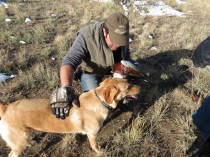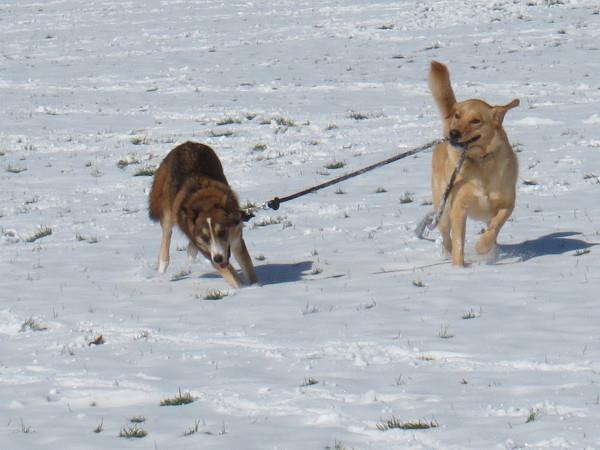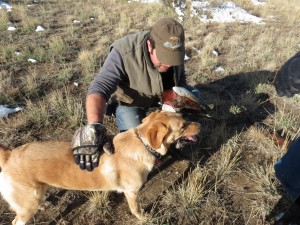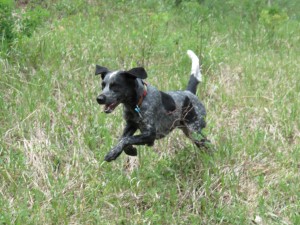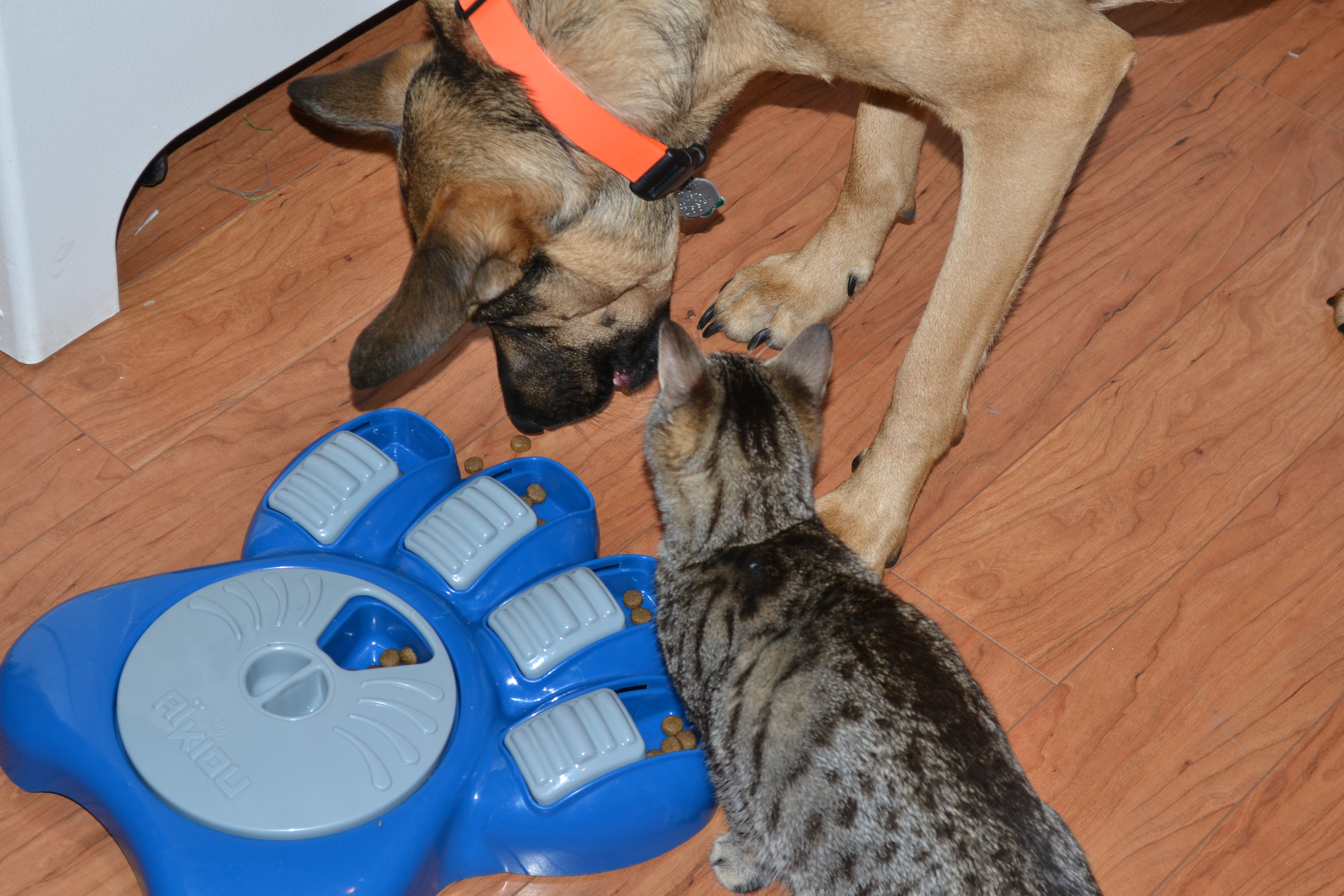Foreword: Recently, I learned about a gun dog trainer in Colorado who trains dogs without shock collars. I could not wait to get a hold of him and have him write a post about off leash control. I hope that you enjoy his perspective and I hope to share more posts from him in the future! His name is Thomas Aaron of FetchMasters, LLC and the Positive Gun Dog Training Program in Denver, Colorado. Enjoy!
Off-Leash Reliability from a Positive Gun Dog Trainer’s Perspective
Clients on the pet-dog side of my business often hire me to train their dogs for off-leash reliability. Here in Colorado, many people seem to visualize off-leash reliability as a dog running wild in wide-open spaces, and yet obediently leaving the chase when called off of a jackrabbit or a deer. It is nice imagery, albeit unrealistic for most dogs. Once dogs become accustomed to pursuing their own agendas without restraint, it is exponentially more difficult to rein them back in. I typically use my gun dog to demonstrate my own flavor of off-leash reliability.
When I remove her leash, she stays within about a 30-yard radius of me and adapts to whichever direction I am moving. She looks at me often to see if I have any instructions for her. When I say “come,” she comes, and when I hold my left or right arm parallel to the ground, she will begin moving in the corresponding direction. The only time she will move beyond her 30-yard radius is if I throw something beyond that radius for her to retrieve – but then she comes speeding back to me and resumes life within the acceptable bounds. With those skills, and that level of responsiveness, activities like hiking, camping, and going for off-leash walks on the outskirts of town are a pleasure.
From a gun dog training perspective, there are two factors that must be considered when developing this level of control: context and habit.
Context
All good trainers know that dogs are better at discrimination (that is, learning specific lessons from specific circumstances) than they are at generalization (applying a lesson learned in one circumstance to other circumstances). Another way of thinking of this is that dogs are contextual learners. They are fully capable of learning that in one context (indoors, for instance), they must obey a certain set of rules, but that in a different context (i.e. outdoors), they are free to jet off into the wild blue yonder and do whatever they want.
R+/P- trainers also understand that it is as important (if not more so) to train the behaviors we want as it is to fix the behaviors we do not want, and we find it easy to apply this principle indoors. For example, we know it is inadequate to punish a dog for charging the door when we are answering it, jumping on guests, chewing on the sofa, and stealing a sandwich from the table. We know we must teach him skills that are incompatible with the unwanted behaviors. We teach him to sit-stay while we answer the door, to keep all four feet on the ground to get attention, to chew on his Kong and Nylabone, and to lay on his bed while we eat in the dining room. By doing these things, we teach job skills (if you will humor me and make that leap) that he should perform when he is in the context we call “indoors.”
However, we often adopt a different philosophy when it comes to teaching dogs how to behave in the context we call “outdoors.” Instead of teaching them a comprehensive set of job skills to execute, we teach emergency measures to stop unwanted behaviors. For example, we teach “leave-it” to keep our dog from feasting on (evidently scrumptious) goose poop; “come” to call him back when he takes off after vermin; and “look at me” when we want him to break his attention away from a squirrel he is trying to drag us towards.
Relatively speaking, it seems almost a punishment to give him a mere ‘attaboy or a piece of Pup-Peroni in exchange for his giving up such a potentially reinforcing pursuit! I am not saying reliability cannot be achieved using this approach, but from a gun dog training perspective, this methodology seems more focused on subsidizing inefficiencies than on creating a comprehensive way of life in the “outdoors” context. There is another way (still heavily focused on R+ training) to develop off-leash reliability.Gun dogs are taught from puppyhood that being outside means one of two things: they either are training or working. Period. They are not allowed to run amok with other dogs in wide-open spaces. They (and any training environments) are closely controlled so that they never have the temptation or opportunity to bolt after a rabbit. For months, all they do is learn that being outdoors means staying close to the owner, following instructions, being steady, and retrieving items only when sent out to do so. Significantly more effort is spent teaching gun dogs context-specific skills than what is spent correcting problems. And when hunt day comes, they hunt. But how does this translate to pet dogs?
When training pet-dogs for off-leash reliability, I teach them three job skills they will be expected to perform whenever they are in the “outdoors” context. First, they spend a lot of time on a long lead learning to operate within a specific perimeter of the owner. During the course of the training, they never are allowed to run free. Second, they learn to adjust to the owner’s direction of travel. If the owner changes directions, so must the dog. Third, they are taught that being in the “outdoors” context means they frequently will be asked to perform their obedience cues (particularly “stay” and “come”). This is a pet dog’s job when outdoors: stay close, move with the owner, and follow obedience commands. But these skills will amount to nothing unless they are ingrained deeply enough into the dog’s psyche to become standard operating procedure – or, put another way, habit.
Habit
The easiest way to avoid unwanted behaviors is to never let them develop. For this reason, it is much easier to develop off-leash reliability with a puppy (who wants to stick close to you) than it is to convince an adult dog that is accustomed to gallivanting off into the distance that he does not want to do that anymore. The primary difference between the pup and adult dog is the amount of time it takes to develop the habit of staying close to you. Older dogs (unless they have abandonment issues and cannot stand to be away from you) usually will be more time-consuming to train.
Both dogs will need plenty of time and practice in the “outdoors” context to develop the habit of staying close, adjusting their direction of travel, and performing their obedience commands. To prevent the puppy from learning bad habits (and to keep the adult dog from acting on the ones he has already developed), I ask clients to never let their dogs run free under any circumstances; they must have a long-lead on the dog and be actively training any time the dog is not indoors. Regressions like chasing small prey animals are so overwhelmingly rewarding that mishaps can set your training back significantly. With a long lead, you can prevent this from happening while constantly reinforcing the behaviors your dog is being trained to perform.As a dog becomes habitually tuned into the owner, I allow him to drag the long lead and eventually wean him from it. But it is important not to trust the dog prematurely or rush the process. If the dog runs away on the long lead, it only teaches him that he can, and that too sets back the training. Patience, avoiding unwanted behaviors, reinforcing job skills, and time are the necessary ingredients for bomb-proof off-leash reliability – at least from a gun dog trainer’s perspective.
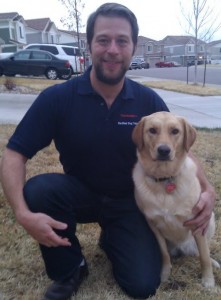
Author Bio: Thomas Aaron is the owner of FetchMasters, LLC, in Denver, Colorado. He specializes in training dogs for off-leash reliability using positive reinforcement methods, and he has recently established the Positive Gun Dog Training Program to offer an alternative to traditional, punishment-based methods for training reliable hunting dogs. Thomas is ABCDT Certified and a full member of the APDT.
